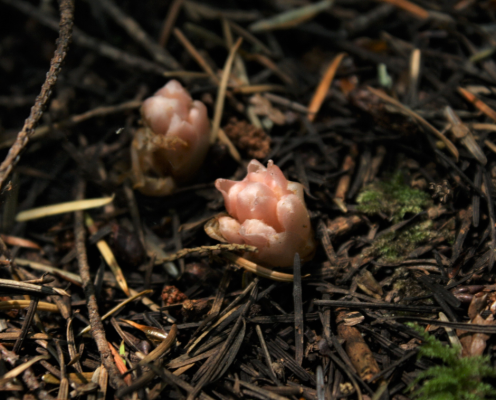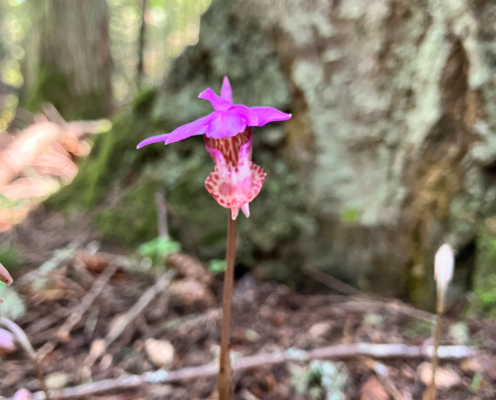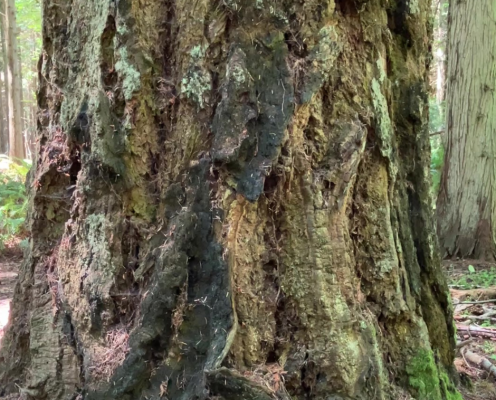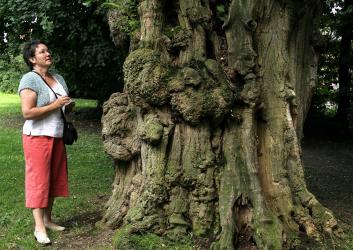Wander into the wild: A guide to the enchanted forest of Fort Townsend
Welcome, wanderer!
Deep in the mossy folds of Washington’s Olympic Peninsula lies a forest brimming with secrets, where sunlight filters through ancient canopies, and magic seems to hum beneath your boots. Fort Townsend State Park isn't just a historic fort and scenic woodland escape, it's a living tale of interconnected life, from parasitic plants and mythic fungi to forest elders. Here's your magical guide to just some of the spellbinding life forms you'll meet along Fort Townsend’s new temporary interpretive trail, Tales & Trails: Magic of the Forest.

🌿 Plants with a magical twist
Ghost plant (Monotropa uniflora)
This spectral beauty lacks chlorophyll and doesn't photosynthesize. Instead, it siphons sugars from the underground fungal network — nature's own Wood Wide Web. Look for its eerie white bloom May through August.
Gnome plant (Hemitomes congestum)
Like a ghost plant’s mischievous cousin, this rare, fleshy pink bloom relies on the Devil’s Tooth fungus for nourishment. Keep your eyes low — it only surfaces a few months a year, from May to August.
Sugarstick (Allotropa virgata)
It may resemble candy canes, but beware — this striking parasitic plant is no treat. It depends on fungal networks and may lie dormant for years before blooming from May to August.
Spotted coralroot (Corallorhiza maculata)
Named for its coral-like roots, this “pretty little vampire” feeds off fungi in the shaded understory. Despite its lack of leaves, it adds vibrant pops of color between April and August.

🌱 Forest healers and survivors
Stinging nettle (Urtica dioica)
Feared for its sting, this plant is actually a powerhouse of nutrition and utility. Brewed into tea or woven into textiles, it's a living symbol of resilience.
Pacific trillium (Trillium ovatum)
With three perfect petals, this elegant early bloomer helps pollinators and spreads via ant-assisted seed dispersal. Found only in undisturbed woodlands, it’s an emblem of balance.
Evergreen huckleberry (Vaccinium ovatum)
From the brink of overharvest to resilience, this berry-bearing plant is a favorite for both wildlife and foragers, especially during its fruiting season in late summer.
Fairy slipper (Calypso bulbosa var. occidentalis)
Rare and delicate, this orchid is as elusive as the fairies it’s named for. It dies if picked, reminding us to admire without harm.

🍄 Fungi, lichens & moss: Magic beneath your feet
Devil’s tooth fungus (Hydnellum peckii)
A rare find indeed! Known for its bleeding appearance, this fungus actually helps trees like Douglas fir trees thrive. Its vivid red “blood” is just sap — and insect food.
Witch’s butter (Tremella and Dacrymyces spp.)
Jelly-like and bright, these fungi are stars in folklore. Some believe they ward off curses — others just enjoy their strange texture in candy!
Fairy fingers (Clavaria fragilis)
Thin white stalks reach from the earth like otherworldly digits. They're not just spooky; they break down dead matter, aiding forest renewal.
Slime mold (kingdom Protista)
Neither mold nor slime, these mysterious forest guests are ancient recyclers — living art forms with behavior that defies logic.
Gold dust lichen (Chrysothrix spp.)
Tiny golden crusts on tree bark — these slow-growing lichens are like forest tattoos, indicating clean air and ancient life.
Old man’s beard (Usnea longissima)
This hanging lichen absorbs air quality like a natural monitor. If you see it swaying in the breeze, the forest is thriving.
Glittering wood-moss (Hylocomium splendens)
Feathery green carpets line the trail, shimmering after rain and shrinking during drought — one of the forest's most adaptive residents.

🌲 The Ancient Trees
Western redcedar (Thuja plicata)
The "Tree of Life" lives up to its name — providing medicine, shelter and symbolism across cultures. These giants may live over a millennium!
Douglas fir (Pseudotsuga menziesii)
This flame-resistant titan defends itself with thick bark and sticky sap. It’s a cornerstone of the Pacific Northwest’s forest structure.
Nurse logs
Fallen trees transform into nurseries for saplings, fungi and mosses, recycling their nutrients in a final act of forest generosity.
🗺️ Explore the new temporary interpretive trail
Tales & Trails: Magic of the Forest
📏 Distance: 1.2 miles
🔁 Loop trail with interpretive signs that begins at the Camper’s Trail in the campground
🕰️ Best seasons: Spring through early fall for most blooms and berries, and fall through winter for variety of fungus
Fort Townsend State Park is not just a walk in the woods — it's a journey through a living fairytale. Let your senses guide you. Look low for coralroots and gnome plants, glance up for lichen and slime mold and listen — always — for the whispered magic of the forest. Return often. The forest changes with the seasons, and new secrets are always waiting to be discovered.
We invite you to hike the rugged, winding interpretive trail to experience the wonder firsthand, or explore from home by reading the interpretive signs on our website. However you choose to journey, the forest is always waiting to share its magic.
Originally published June 10, 2025




